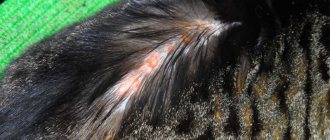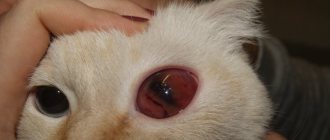Causes
Young animals get sick. Clinically healthy animals can be bacteria carriers. Most often, mixed infections occur, which are collectively called kennel cough based on the main symptom. Animals kept individually get sick very rarely. An important condition for the development of infection is its intensification during passage through many organisms. No pronounced seasonality of bordetellosis outbreaks is observed. The cause of infection may be:
- importation of new individuals without quarantine;
- Exhibitions;
- crowded content;
- stress;
- hypothermia.
The latent period lasts 5–20 days. Signs of the disease in cats are the same as in dogs.
Cats in the nursery
What is bordetellosis in cats?
This disease is caused by the bacterium Bordetella bronchiseptica. Bordetellosis can be transmitted from animals to humans. This doesn't happen often. Infection with the bacterium mainly occurs in people with weakened immune systems.
Bordetellosis in cats is often the cause of coughing throughout the cattery, as the bacterium is released when sneezing and in saliva. A domestic cat can easily bring bordetella from the street.
Feline bordetellosis, together with viral diseases - calicivirus and herpesvirus, leads in the number of causes of inflammatory diseases of the upper respiratory tract. Infection occurs through contact. The source of the spread is homeless animals that hide from the cold in basements during the autumn-winter and spring periods. It is enough for one animal to get sick for the entire population in this area, which is in contact with each other, to get sick.
Bordetella is a resilient bacterium. During sneezing or expiration, it is released into the environment, where it can remain viable for 10-14 days, depending on temperature and humidity. This causes infection of domestic cats through the owner's shoes. If a person steps on the saliva or discharge of a sick animal, and his pet cat sniffs his shoes, he can become infected. This transmission route allows the bacterium to infect a large number of animals when environmental conditions suitable for survival appear.
Symptoms
The disease occurs in the following forms:
- Spicy.
- Permanent.
Dogs in the kennel
Acute form
Most often, kittens and puppies are affected during the first 12 weeks of life. The disease is characterized by the following symptoms:
- poor appetite;
- sneeze;
- cough that gets worse when standing up and moving around;
- sputum separation;
- oppression, the baby is constantly lying down;
- temperature rise - 40–41 °C;
- exhaustion.
With improper treatment, bronchitis develops, turning into pneumonia, which often ends in the death of the animal.
Chronic form
It is characterized by the same signs as acute, only they do not appear so clearly. Additional symptoms appear:
- conjunctivitis with copious discharge;
- rhinitis accompanied by nasal discharge;
- lymphadenitis with hypertrophy of local lymph nodes in the submandibular space.
Signs and symptoms of bordetellosis in cats
The appearance of the first signs of the disease depends on the immune system. Kittens, pregnant and lactating cats with chronic diseases become infected faster and tolerate the disease much worse.
When cats become infected with the bacteria, symptoms include:
- there is a decrease in appetite and refusal to eat;
- she becomes lethargic;
- sneezes, mucus begins to come out of the nose;
- A cough occurs, which begins to intensify with any movement.
Subsequently, sneezing and watery eyes appear. Already at this stage, body temperature may increase. Wheezing and an increase in the size of the lymph nodes under the lower jaw are characteristic of the active phase of the disease. Weak cats may experience shortness of breath and bluish mucous membranes. Without adequate treatment, the animal may develop pneumonia.
The first signs appear 7-10 days after infection. It is not uncommon for cats kept together to become ill at different times. For most robust adult animals, even severe bleeds and wheezing do not cause pulmonary failure and cyanosis. The most dangerous disease is for kittens up to three months of age, pregnant and lactating females. Their risk of pneumonia is 15-20% higher.
Like most respiratory diseases, bordetellosis develops when the bacterium enters the respiratory system, where it attaches to eyelash cells. This is followed by the production of toxins that destroy local immunity. Damage to the mucous membranes makes it easier for toxins to enter the blood. Afterwards, the entire body becomes infected.
Bordetellosis is characterized by a prolonged paroxysmal cough. Presumably it is not caused by a bacterium, but by the action of its toxins on the respiratory center.
An adequate immune response avoids infection. For adult animals, it is produced through vaccination. In the first 4-5 weeks of life, young animals are protected by maternal antibodies if the mother has immunity to the disease.
During the course of the disease, the immune system of an adult animal produces enough antibodies to the bacterium, but their lifespan is variable. Even within 1 year, it is impossible to guarantee the absence of re-infection of a recovered cat.
Diagnostics
Even preliminary diagnosis based on clinical signs alone is untenable. Similar symptoms are observed in the following diseases:
- herpes;
- calcivirosis;
- mycoplasmosis.
Therefore, the pathogen is identified by PCR. When autopsying dead animals, pay special attention to spotting of the lungs, which indicates developed pneumonia. Foamy sputum is found in the tracheal tube and bronchi. Bordetellosis often occurs in conjunction with other ailments, which must be taken into account when prescribing treatment.
General recommendations for vaccination
Currently, only one vaccine against feline bordetellosis is available. The purpose of use is to reduce the manifestations of the disease and the risk of infection of other animals.
The procedure should not be performed before four weeks of age. Its use together with other medications intended for intranasal administration is prohibited. An animal cannot be vaccinated while taking antibiotics.
As a result of vaccination, an animal may:
- sneezing;
- serous discharge from the eyes and nose.
All of the above goes away on its own within 1-2 days.
A cat can be vaccinated from four weeks of age. The vaccine is administered into one nostril to develop a rapid immune response. Already 72 hours after the procedure, a protective titer of IgA antibodies is achieved. The substance is administered 1 time, the procedure is repeated after a year.
Vaccinating cats against bordetellosis is an effective preventative measure.
Vaccination of animals in shelters and nurseries is a mandatory measure, since due to overcrowding there is always a risk of contracting bordetellosis. All cats must be vaccinated once a year.
All animals that are just entering these institutions must be quarantined for ten days. Cats that do not show clinical signs of respiratory disease should then be vaccinated. Cats showing signs of infection should be immediately referred for treatment.
Cats that have recovered from the disease are vaccinated no earlier than a week after the disappearance of any clinical symptoms of the disease.
Veterinarians advise cat breeders:
- Keep cats individually or in small groups.
- Monitor animal hygiene and use appropriate disinfectants.
- Isolate animals with a clinical picture of bordetellosis.
The vaccine can be purchased in almost any country. Its cost is usually low. In many cases, domestic cats do not need it, but if the animal is free-ranging, it is better to vaccinate it.
Veterinarians recommend vaccinating cats that go outside for walks.
Treatment
With timely treatment, recovery occurs within 10–14 days. Bacterial carriage lasts four months. The sick are removed and provided with comfortable conditions. The therapeutic strategy is developing in the following directions:
- antimicrobial therapy;
- symptomatic treatment;
- restorative therapy.
Antimicrobial therapy
A proven treatment for bordetellosis is Doxycycline. Subtitration for sensitivity to antibiotics is indicated if the disease has become widespread, and the use of Doxycycline has not had the desired result. It must be taken into account that the cause of kennel cough may be a complex concomitant infection, so the veterinarian prescribes Gentamicin or fluoroquinolones.
Doxycycline hydrochloride
Symptomatic treatment
Sick animals are regularly examined and the nose and eyes are cleaned of crusts of dried exudate. Expectorants are used under strict veterinary supervision. All drugs are potent, with many side effects. For individual treatment, the following products are used in the form of drops:
- Immunomodulators:
- Anandin;
- Maxidin;
- Thymogen.
- Anti-inflammatory:
- Naphthyzin;
- Dioxidine;
- Nazivin.
- Antiseptic:
- Diamond eyes;
- Iris;
- Leopard.
Aviary cough in dogs - diagnosis of the disease
Diagnosis of bordetellosis presents certain difficulties. This is due to the similarity of clinical symptoms with other infections. It is recommended to isolate bacteria from nasal and throat washes.
Next, the samples must be sent to the laboratory. For the transport of biological material, special coal-dust media are used. Coal-dust cephalexin agar is used for inoculating bacterial cultures. To make a final diagnosis, cytological and bacteriological analysis is performed. High efficiency is characteristic of the polymerase chain reaction (PCR). This method facilitates quick and correct diagnosis of the disease. It is based on the study of the DNA structure of a microorganism.
Bordetelliosis in dogs must be distinguished from some forms of plague, nonspecific tonsillitis and tracheobronchitis.
General restorative therapy
It involves the use of immunostimulating medications. The following drugs are in demand:
- Ribotan;
- Gamavit.
It is necessary to refrain from using Levamisole as an immunomodulatory agent, which is contraindicated for sick and weakened animals. Complications that arise often result in the death of the pet. When treating bordetellosis, an important condition is good nutrition, ideally premium wet canned food.
Nobivak
How to protect your cat from disease?
In general, unlike dogs, which often become infected while walking, cats are real “homebodies.” If you only have a cat in your apartment, then the likelihood of illness is quite low. But, if you are an active participant in various cat shows, and also constantly hang out in the community of cat lovers, then the chance of your pet catching this disease increases several times. In the end, you can simply bring the pathogen home on your clothes or shoes.
The most reliable method of prevention is vaccination. In particular, the drug Nobivak Bb has proven itself to be excellent. Just one visit to the veterinarian will help you protect not only your cat, but also your other pets. However, we also strongly recommend vaccinating them. This is done once a year, so this event will definitely not take up much of your time.
Prevention
Preventive measures are related to the organization of proper maintenance in the nursery. For young animals, it is necessary to have premises in which the microclimate is regulated. Newly arrived individuals are kept in quarantine. In order for the animal’s body to resist infections, adequate nutrition is provided.
Crowded housing requires a forced measure to protect the livestock from infection - universal immunization with Nobivac (Bb) vaccines for cats, as well as Nobivac KS for dogs. Both drugs are instilled intranasally. Initially, puppies or kittens that have reached the age of one month are vaccinated. Reimmunization is not required. The procedure is repeated annually. Clinically healthy, previously dewormed animals are immunized. The use of antimicrobial agents during the vaccination period is not permitted. Post-vaccination complications occur in the form of sneezing, mild conjunctivitis and go away on their own.
Nobivak
Bordetellosis is an infectious disease of dogs and cats of bacterial etiology, characteristic of crowded housing in kennels. Treatment is difficult due to the large number of cases. Prevention consists of ensuring proper housing and feeding conditions, as well as immunization of livestock.
We invite you to join our Zen channel and group on VKontakte or Odnoklassniki, where new articles for pet owners are published.
Similar articles:
- What is separation anxiety in dogs and how to deal with it?
- Ringworm Caution: What Pet Owners Need to Know
- Tuberculosis in dogs
Etiology
A characteristic feature of Bordetella is their tendency to change antigenic properties and growth patterns on nutrient media under the influence of a number of factors: temperature, humidity, pH.
- Morphology. Bordetella is a coccobacilli or small rod that has an ovoid shape. The bacterium is asporogenous and nonmotile, except for the species B. bronchiseptica. The causative agent of whooping cough has a microcapsule.
- Tintorial properties. Gram-stained red. They are located singly in the smear, sometimes in pairs.
Bordetella pertussis
Cultural properties. Bordetella pertussis grows on complex nutrient media containing antibiotics, sorbents and growth stimulants. Antibacterial drugs are intended to suppress the growth of accompanying flora, which inhibits Bordetella. To isolate pertussis bacillus, media with amino acids, blood, resins, and coal are used. Such environments include Bordet-Gangou and AMC. Other species grow on simple MPA. Temperature optimum 35-36°. Smooth, transparent, convex pearl-colored colonies with shine grow on Bordet-Gengou medium. They resemble droplets of mercury. On KUA medium, colonies have a grayish-cream tint. In the broth, bacteria grow in the form of a uniform turbidity and a dense sediment at the bottom. Bordetella causes hemolysis of red blood cells.
- Physiological properties. Bordetella is an aerobe, chemoorganotroph. For its metabolism, the microbe uses the oxidation products of amino acids: glutamic, aspartic. Their growth occurs in the presence of cysteine and nicotinic acid. Bordetella is sensitive to sunlight, high temperature, and basic antiseptics and disinfectants. Microbes remain viable for several hours in dry sputum.
- Biochemical properties. B. Pertussis practically does not ferment sugars, is oxidase-positive and catalase-positive, does not produce urease, nitrase and does not contain citrate, ferments glucose and lactose with the formation of acid.
- Pathogenicity factors: fimbriae; adhesins; a thermostable protein that ensures the toxin enters cells; dermonecrotic toxin, causing necrosis and cell death; tracheal cytotoxin, damaging the epithelial layer; endotoxin, which stimulates inflammation and is immunogenic; microcapsule of B. pertussis protects against phagocytosis; enzymes – hyaluronidase, lecithinase, plasmacoagulase, adenylate cyclase.
- Antigenic structure. Bordetella has a somatic O-antigen and 14 capsular K-antigens, which give Bordetella pertussis resistance and protect the bacterium from attack by leukocytes.
Under natural conditions, microbes are constantly influenced by many factors that determine the process of variability. Bordetella have genetic and phenotypic variability. A pathogenic culture that produces toxins gradually loses its virulent properties and pathogenicity factors in laboratory conditions. This is the so-called genetic or mutational variability of bacteria. Another mechanism for the “transformation” of Bordetella into avirulent forms is phenotypic variability. It is associated with the appearance of non-pathogenic forms as a result of the cultivation of microbes in conditions unsuitable for their life.











